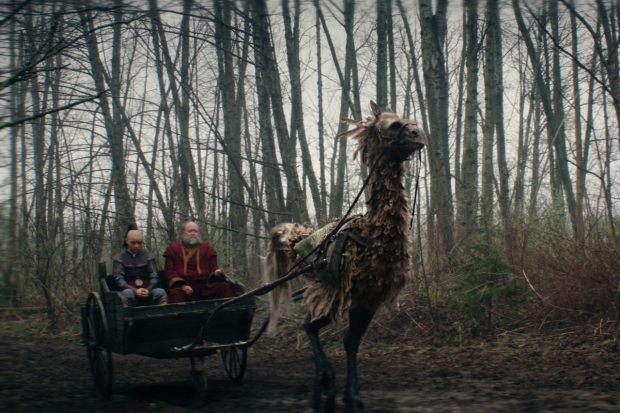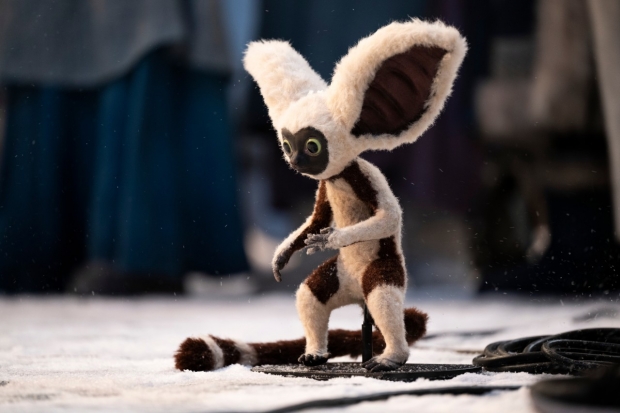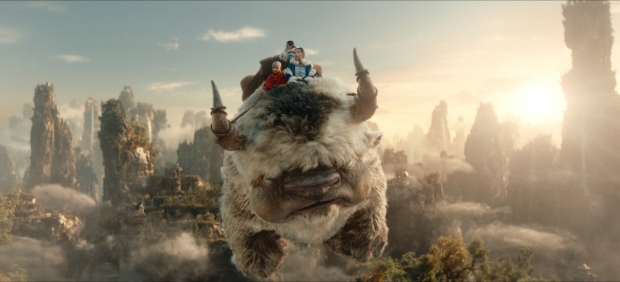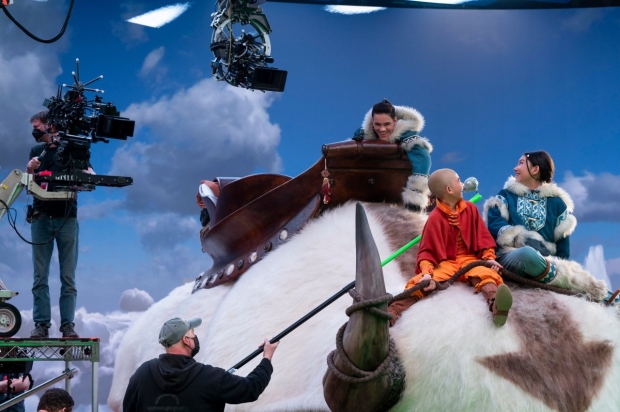VFX supervisor, director, and executive producer Jabbar Raisani led a monumental effort to deliver almost 3,400 visual effects shots on the live-action adaptation of Nickelodeon’s famed animated series, recreating the magical world of benders, who control the natural elements of fire, water, wind, and earth, and the mediator known as the Avatar.
Live-action adaptions are always tricky, especially when the source material is a beloved animated series. Established fans must be catered to, while new viewers must be attracted to expand the overall audience base. Then there is also the fact that animation and live-action have different strengths and weakness that don’t allow for a straight 1:1 translation. But then, what would be the point even if that was possible?
In Nickelodeon’s all-new live-action series, Avatar: The Last Airbender, now streaming on Netflix, the world is divided into four nations, each with the ability to control a different natural element: fire, water, wind, and earth. Serving as the mediator between these nations is a reincarnated spirit, known as the Avatar, with the ability to master and control all four elements. Jabbar Raisani serves similarly as a type of Avatar on the production, juggling the roles of VFX supervisor, director, and executive producer. “One more position on the show!” laughs Jabbar Raisani. “I’ve been in the props department a few times. Ted Biaselli, who was our creative executive on Lost in Space, was also the creative executive on this. Working on post-production for Avatar: The Last Airbender was as close as you could get to carte blanche of, ‘Do what you need to do to make the show great.’ And that streamlined the process.”
That streamlining, however, was no simple task, as the monumental effort required five visual effects supervisors: Raisani, Marion Spates, Jared Higgins, Christopher D. Martin, and Alex Gitler; two special effects supervisors: Chris Flemington and Mark Gibbard; and two stunt coordinators: Jeff Aro and Dean Choe. “The complexity of the show is unbelievable, from all of the environments, creatures, and bending,” notes Marion Spates. “It goes on and on. There were so many visuals that we were trying to make over the course of the season; it takes a lot of people to pull it off.” To produce close to 3,400 visual effects shots, the workload was divided among main vendors Framestore, Important Looking Pirates, Scanline VFX, Accenture Song VFX, Cadence Effects and Rodeo FX as well as additional support from Pixomondo, Image Engine, Untold Studios, Outpost VFX, BigHugFX, Cadence Effects, The Resistance VFX, Atomic Pictures, NEXODUS, FABLEfx, and DNEG VP. “Marion and I spent a lot of time on the assets, so the shot work went much faster,” remarks Raisani.
Bending took considerable trial and error to get right. According to the VFX supervisor, “A specific example being firebending, where initially you’re trying to make it not look like it’s a combusting thing, because they’re conjuring fire. But when you don’t have those things associated with fire, like smoke and sparks, it starts to not look grounded. It feels graphical. A lot of it was figuring out the recipes that made the characters the characters, the bending the bending, and this world of Omashu. Once we got the assets right then it’s, ‘Okay, go! Go faster.’”
An unexpected bonus came from the principal cast. “I was talking with Jeff Aro about a fight sequence in Episode 103, where Prince Zuko [Dallas Liu] has to fight Aang [Gordon Cormier] but can’t use firebending because he’s in Omashu and can’t reveal that he’s a bender,” recalls Riasani. “In discussing the process he said, ‘You don’t know about Dallas’ abilities, do you?’ I said, ‘What are you talking about?’ He said, ‘Dallas is a world class martial artist. If you asked him to, he could do a flip right now.’ Jeff showed me a video of Dallas. I went, ‘Okay, we don’t need someone else to do this stunt.’ He was like, ‘No. Dallas can do 100 percent of his own stunts and with the stunts bending as well. It was a pleasure to work with the cast.”
The cast went through six weeks of boot camp, each learning their own discipline when it came to bending as well as learning the other disciplines and various martial arts forms that went into their style of bending. “It was cool and great to work with a cast that embraced each of their bending forms but also understood the other forms,” Riasani notes. “One of the things I didn’t realize is that it was a lot more like a choreographed dance and you couldn’t make-up a bending move on the day.”
For water, simplified geometry was animated to portray the water whips to create a sense of scale and what it was doing. “That simple geometry would drive the simulation as far as the shape and then we would add real world components to it like with our water we added foam,” explains Spates. “We have the water surface, foam, and spray. Jabbar came up with this other thing that we did called the ‘barbershop.’ To get the swirl and movement of the whip, she gets better at it over the course of the season. You know the classic barbershop sign, the pole. That’s the barbershop. All our vendors started to learn our language. We need more barbershop so they would add more barbershop as they were doing the simulation being driven by a simplified object that is animated, which creates the whip.” Actual water was used sparingly. “It came down to a practical limitation in terms of if we get this actor wet then they’re going to go through hair, make-up and wardrobe again, so a reset could be 30 minutes to an hour,” notes Raisani. “You can’t do that effectively onset, especially when you’re working with young actors who have limited hours. There were instances where it was, ‘Okay, now we’re going to do the last take. Now we can use water. Did we get it? Is it reference? Who knows, but at least we did what we could to do it in camera without compromising the actual production.’”
Every tool in the book was deployed when it came to worldbuilding. “There are regular sets, interior sets, the volume, standard greenscreen and bluescreen work, location work, and sets on location,” explains Raisani. “We used all the tools, and as much as we could, tried to use the right solution for the right set or scene. In some instances, it worked 100 percent, and other instances, visual effects needed to help fine tune certain aspects, whether it be the volume, or set, or push things further with the greenscreen than initially anticipated.”
Color grading assisted in making some of the fixes. “We had an amazing colorist, Siggy Ferstl,” Raisani shared. “This is our 36th episode of television that we’ve done with him. We leaned on him heavily. He is fantastic. If the volume was a bit lifted and didn’t quite fit in with the black levels, he would go in and dial all that stuff to marry the two together. We certainly leaned on him and where we needed to go further, we would push into visual effects and augment where necessary.” The LED volume came in handy for specific scenes. “Exterior direct sunlight is still the hardest thing that you can do in the volume or at least for the volumes we have been working on,” Raisani continues. “On interior sets or nighttime scenes, it did a lot better job, such as the interior of Omashu, the dining room, and throne room where Aang first meets Bumi. That stuff needed minor cleanup with one of our vendors. But for the most part that stuff worked well in-camera. There is a night boat scene in Episode 102 that was successful. And so was the Fire Nation throne room.”
Omashu, the second largest city in the Earth Kingdom, was a major asset build. “Accenture Song VFX did the Omashu asset,” states Raisani. “It was the largest asset that they’ve ever built. That happened to be in the block that I directed. There were a lot of South Asian cultural references. We tried to lean on Pakistan, India, and we were pulling different kinds of architecture, wardrobes, and color palettes, like green from the animated series to try to differentiate Omashu and the Earth Kingdom. In terms of the visual effects side of things, we started with what Michael Wylie, our production designer, gave us in terms of the palette and went from there.” Spates shot some helicopter photography of rocky terrain for visual reference, explaining, “Accenture Song VFX were able to build some photogrammetry out of that terrain as well to help them with the actual building of the asset. One thing that we wanted to stay true to also was the pyramid feeling of Omashu when you look at the wide shots of the mountain. We did a lot of rounds on the wall. How curved it is. How much undulation it has. How does the rock form into the wall? Those buildings have been Earthbended out of a rock, so we had to make it feel like the earth has come up with the buildings protruding up out of the rock. That was actually fun to figure out.”
The biggest challenge was recreating beloved creatures Appa and Momo. “They needed to perform and be right there with Sokka, Katara and Aang, and bring not only a visual performance but a character performance to the screen,” states Raisani. “That was a great part. There is a scene I directed, and Marion supervised, where Aang is getting ready to fly off before the Southern Air Temple attack. It was great to be able to talk with Gordon Cormier about his performance, but also talk to Marion about Appa’s side of the performance. We were talking about the same beats, what Appa would be doing in that moment, and how Gordon would be reacting. We had a prop of Appa’s face onset. It was a green face with no motion, so Gordon knew where to look and understood where Appa’s face was. But the emotion of Appa’s side of things was brought to life by visual effects. We had a little stuffie of Momo for lighting reference. But it was much harder to represent Momo than it was for Appa.
Framestore New York worked on Momo, while Framestore London worked on Appa. “Framestore New York did a lot of research on their own for the emotional beat that Jabbar was looking for with the performance of a monkey that could actually be part of Momo’s performance,” remarks Spates. “That way, at least as we’re animating Momo, we can always refer back to this specific video that showcases the performance we’re trying to pull out of Momo for that particular moment. That was helpful as far as bringing him to life. As far as animation is concerned, we start everything on a few keyframes until we get it all blocked out and then we refine as we’re getting closer and feel like we’ve achieved all the beats we are looking for in that particular shot.”
Conceptualizing the badgermole required referencing an iconic animal performer. “A badgermole has to be big and heavy, but it’s a badgermole,” remarks Spates. “A badgermole is small. So, we looked at a bear. As we were thinking about the bear, we need to find a performance of a bear. You can find stuff of it roaring but Bart the Bear was actually used in films years ago, so we referred back to some of Bart the Bear’s original performances to get the emotion, meanness and scale out of it which was absolutely awesome. When we found Bart the Bear we went, ‘Alright this is perfect.’ Barnstorm did a good job of getting all the emotion and characteristics into the badgermole.” There show also features a fan-pleasing cameo. “The Cabbage Man was in my episode, and we were keeping it a secret for a long time,” reveals Raisani. “We had a little hint in the first teaser where we put in this wide shot of Omashu a tiny cabbage cart, and of course fans spotted it somehow. He was awesome. He was great to work with. The actor who played the Cabbage Man in the original series also plays him in our show. It was fun to cameo him. I probably have 50 pictures of him from onset because I was so happy that he was in my episode!”
Conceptualizing complex shots has become a specialty for Dirk Valk, previs supervisor for the series. “Dirk comes up with insane shots that no one would try to attempt in their right mind,” laughs Raisani. “We’ve worked with him long enough to know that he is going to come up with those kinds of shots. As much as we can, we want to bring those shots to the screen. One of those shots is in Episode 108. There is a group of waterbenders who are on this part of the Agna Qel’a wall, and it gets destroyed by the Fire Nation; they plummet into the sea as we come to find Zhao’s ship which is barreling at the wall. It actually crashes into the wall as we find a waterbender witnessing the action; he goes across this top of the wall as there are crevasse fireballs bombing down around him. The waterbender goes up to the other side of the wall and looks down as the ship breaks through the backside of the wall; the part of the wall he’s on top of collapses, sending him to his probable demise. That shot was probably one of the hardest shots that we did. ILP ended up taking on the challenge, but it was one of those shots where you look at it and go, ‘How are we ever going to actually pull this off?’ You give it to a vendor, and like anything, you start one step at a time, working through each problem over and over until you have all the pieces there. We’ve worked with ILP for a long time so there’s a lot of trust there that they would get there. But it was a long road.”












